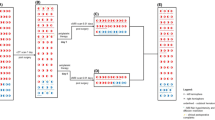Abstract
Background
The clinical and radiologic outcomes of symptomatic adult moyamoya disease (MMD) patients who have an occluded anastomosis immediately after bypass surgery are poorly studied. The clinical and angiographic outcomes of non-patent anastomosis in symptomatic adult MMD patients were retrospectively reviewed.
Methods
From August 2011 to November 2016, 31 revascularization surgeries, consisting of direct and indirect bypass, were performed on 29 adult MMD patients. Primary outcomes were evaluated based on the frequency of transient ischaemic attack (TIA) incidence and the recurrence of cerebral infarction and were assessed as improvement or worsening.
Results
Among 31 cases, computed tomography angiography (CTA) on the first day after surgery showed patent anastomosis in 20 hemispheres and non-patent anastomosis in 11 hemispheres. Follow-up conventional angiographies showed spontaneous recanalization of non-patent anastomosis in all occlusion cases. The incidence of TIA decreased in both the non-patent and the patent groups. Two newly developed cerebral infarctions were observed, which occurred in the patent group. Patients in the non-patent group also showed clinical improvement after surgery (p = 0.04), and no significant relationship was found between immediate postoperative patency and the primary outcome (p = 0.53).
Conclusions
In our series, regardless of patency immediately after bypass surgery, delayed recanalization and clinical improvement can be expected after bypass surgery for adult MMD.


Similar content being viewed by others
References
Cho WS, Kim JE, Kim CH, Ban SP, Kang HS, Son YJ, Bang JS, Sohn CH, Paeng JC, Oh CW (2014) Long-term outcomes after combined revascularization surgery in adult moyamoya disease. Stroke 45:3025–3031
Jin SC, Oh CW, Kwon OK, Hwang G, Bang JS, Kang HS, Kim JE, Lee SH, Chung YS (2011) Epilepsy after bypass surgery in adult moyamoya disease. Neurosurgery 68:1227–1232
Jussen D, Horn P, Vajkoczy P (2013) Aspirin resistance in patients with hemodynamic cerebral ischemia undergoing extracranial-intracranial bypass surgery. Cerebrovasc Dis 35:355–362
Kim DS, Huh PW, Kim HS, Kim IS, Choi S, Mok JH, Huh CW (2012) Surgical treatment of moyamoya disease in adults: combined direct and indirect vs. indirect bypass surgery. Neurol Med Chir (Tokyo) 52:333–338
Kim H, Jang DK, Han YM, Sung JH, Park IS, Lee KS, Yang JH, Huh PW, Park YS, Kim DS, Han KD (2016) Direct bypass versus indirect bypass in adult moyamoya angiopathy with symptoms or hemodynamic instability: a meta-analysis of comparative studies. World Neurosurg 94:273–284
Kim T, Oh CW, Bang JS, Kim JE, Cho WS (2016) Moyamoya disease : treatment and outcomes. J Stroke 18:21–30
Laurent T, Ronit A, Amir RD, Leodante DC, Christopher W, Karel G, Terbugge MT (2008) Assessment of extracranial-intracranial bypass patency with 64-slice multidetector computerized tomography angiography. Neuroradiology 51:505–515
Mehmet T, Alexander M, Charles LT (2004) Multi-slice CT angiography in evaluation of extracranial-intracranial bypass. Eur J Radiol 52:217–220
Pandey P, Steinberg GK (2011) Neurosurgical advances in the treatment of moyamoya disease. Stroke 42:3304–3310
Scharf J, Schmiedek P, Kemmling A, Gerigk L, Groden C, Horn P (2007) Spontaneous recanalization of occluded standard extracranial-intracranial arterial bypass. Cerebrovasc Dis 23:175–180
Wang L, Qian C, Yu X, Fu X, Chen T, Gu C, Chen J, Chen G (2016) Indirect bypass surgery may be more beneficial for symptomatic patients with moyamoya disease at early Suzuki stage. World Neurosurg 95:304–308
Wilson JT, Hareendran A, Grant M, Baird T, Schulz UG, Muir KW, Bone I (2002) Improving the assessment of outcomes in stroke: use of a structured interview to assign grades on the modified Rankin Scale. Stroke 33:2243–2246
Xu B, Song DL, Mao Y, Gu YX, Xu H, Liao YJ, Liu CH, Zhou LF (2012) Superficial temporal artery-middle cerebral artery bypass combined with encephalo-duro-myo-synangiosis in treating moyamoya disease: surgical techniques, indications and midterm follow-up results. Chin Med J 125:4398–4405
Zhu FP, Zhang Y, Higurashi M, Xu B, Gu YX, Mao Y, Morgan MK, Qian Y (2014) Haemodynamic analysis of vessel remodeling in STA-MCA bypass for Moyamoya disease and its impact on bypass patency. J Biomech 47:1800–1805
Funding
No financial support was received for the submission.
Author information
Authors and Affiliations
Corresponding author
Ethics declarations
Conflict of interest
The authors declare that they have no conflict of interest.
Ethical approval
All procedures performed in this study were in accordance with the ethical standards of the institutional and/or national research committee and with the 1964 Helsinki Declaration and its later amendments or comparable ethical standards. For this type of study, formal consent is not required.
Informed consent
Informed consent was obtained from the study participants prior to their inclusion in the study.
Additional information
This article is part of the Topical Collection on Vascular Neurosurgery - Other
Rights and permissions
About this article
Cite this article
Kim, S.H., Lee, H., Yoo, M. et al. Angiographic and clinical outcomes of non-patent anastomosis after bypass surgery in adult moyamoya disease. Acta Neurochir 161, 379–384 (2019). https://doi.org/10.1007/s00701-018-3733-3
Received:
Accepted:
Published:
Issue Date:
DOI: https://doi.org/10.1007/s00701-018-3733-3




